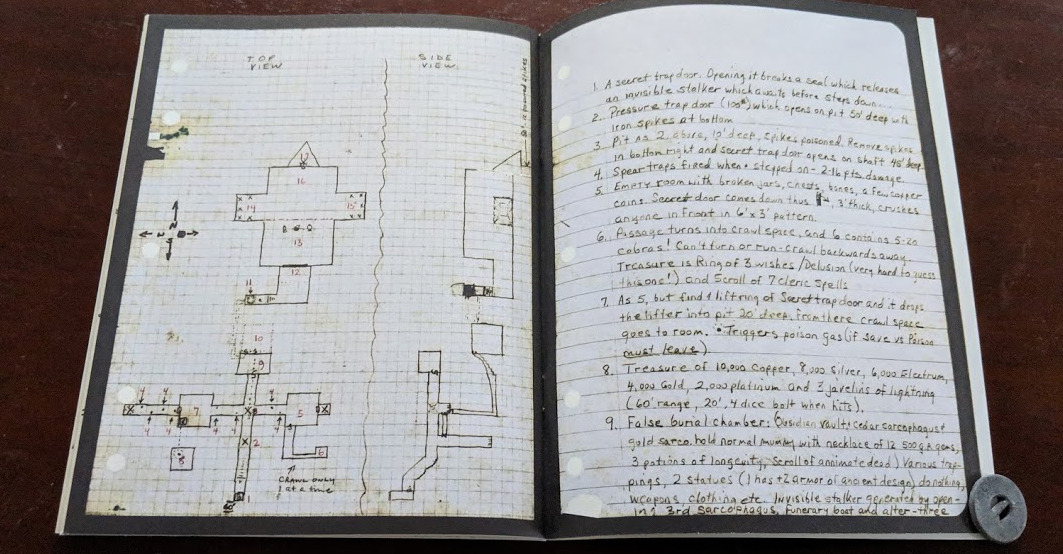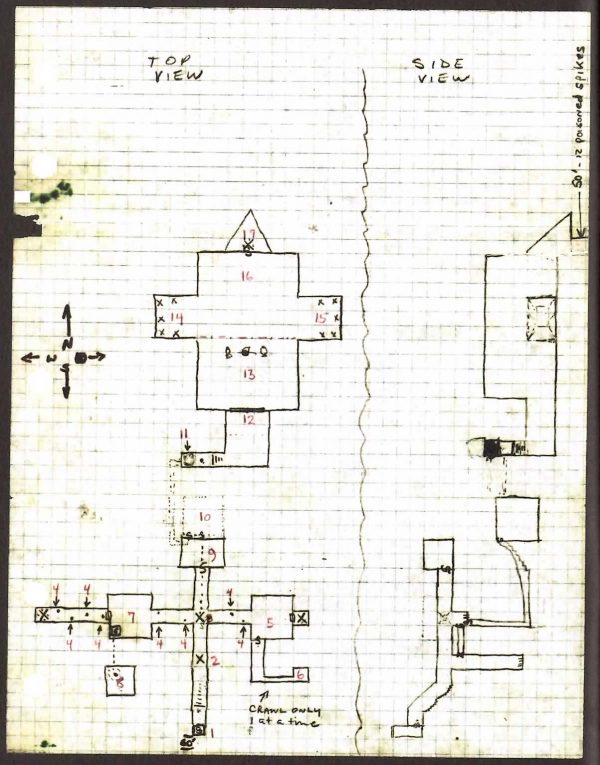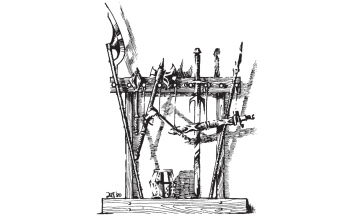
As D&D historians, one of our favorite topics to constantly rehash is the collaboration and eventual schism between the game’s co-creators Gary Gygax and Dave Arneson. Inevitably this spirals into foolish questions like “Who really invented D&D?” In fact this topic was far from my own mind as I started poking into the evolution of the famous module S1: Tomb of Horrors, but its ghost emerged in the form of my own question: “Who the heck is Alan Lucien?”
Tomb of Horrors has got to be the single most recognizable D&D adventure, and also happens to have been the gateway into the world of old school D&D for me personally. Back in April of 2008 Dan ran a session of Tomb of Horrors as a sort of memorial event for the then-recent passing of Gary Gygax, at a gathering that was the progenitor of my now long-running house convention called HelgaCon. I’m now in the midst of planning HelgaCon XII. After playing Tomb of Horrors multiple times I eventually bought the module, mostly just to satiate my curiosity of all that we had missed, and then I moved on. I didn’t really give it a ton of thought until I got my copy of the D&D art book Art & Arcana, which came with a neat little reprint of the original Tomb of Horrors tournament module run at Origins I in 1975.
I thought it would be academically interesting to compare the tournament version to the later printed module version. Interestingly though the booklet also includes as an appendix “The Tomb of Ra-Hotep”, a 5-page dungeon written by Alan Lucien which apparently he sent to Gary Gygax. This is significant as the early covers of Tomb of Horrors includes the following text:
The author wishes to express his thanks to Mr. Alan Lucien who was kind enough to submit the ideas for this dungeon.
My own copy of Tomb of Horrors has a green cover which does not include the above text, though you can see scans of it on the earlier pink cover over at the Acaeum. Fascinating, I thought, I will have to compare all three iterations! So after reading through the tournament module I quickly read the appendix and was left with this one high level thought: “what the heck has this got to do with Tomb of Horrors?”
OK, yes, it’s a tomb with a bunch of traps and a big scary undead creature at the end. In this way the two dungeons are similar. On further reflection there are other ideas present that I imagine inspired parts of Tomb of Horrors, such as the inclusion of a false burial chamber, and a secret door that’s been plastered over. Lucien also devotes one of his five pages to the transcription of some hieroglyphs which the players may translate with a Read Languages spell. Unlike the poem in Tomb of Horrors though, these include boons, curses, and flavor, but no actual clues as to the content of the rest of the dungeon. Also, it’s not totally clear to me where these inscriptions are in the dungeon, nor what Lucien is getting at in his parenthetical:
(For the sake of my sanity I didn’t actually write that message, but the whole looks pretty fair.)
Of particular interest for me, and a place where the Tomb of Ra-Hotep diverges significantly from the Tomb of Horrors, is the map:

The presentation of the same map in both top and side views is something I was not expecting to find as early as 1975. It reminds me of more modern work by the likes of Dyson Logos. I suppose it’s sort of reminiscent of the side-view maps in Basic D&D books, but I don’t think those ever directly tied together a side and top view map. This one also does a great job of playing with vertical space and giving a sense of really claustrophobic crawl-ways and descending shafts. It’s a shame this sort of thing didn’t make it into later works.
It’s also worth noting that Alan Lucien includes the description in his text of a new magic item – the sphere of annihilation. Though not used in the same way as it is in Tomb of Horrors, the rules Lucien made for it are pretty much exactly replicated in the version that shows up in the AD&D DMG. My copy of the Tomb of Horrors simply bolds the name of this item, which indicates to me that I should go look it up in the source book. Perhaps this is one of those ideas that Gygax wanted to make sure Lucien got credit for, but if so the credit feels a bit out of place here in this module rather than the DMG itself.
All that aside, why bring up the specter of Gygax vs. Arneson? Well, in trying to figure out what the ties were between these two adventures, I stumbled upon this Dragonfoot’s forum thread, which poses the same question. A few posts down Paul Stormberg offers this nebulous explanation:
Alan Lucien is to Tomb of Horrors as Dave Arneson is to D&D.
Stormberg never reposts to explain himself, though many users extort him to do so. Ultimately though I suspect I know what he’s getting at. “Developing ideas” is sort of what Gygax was known for, as shown as early as his 1966 “Opponents Wanted” ad in AHG with the line “Will cooperate on game design.” In the process of creating D&D, it appears to me that Arneson spent more time thinking and experimenting, running actual play tests and formulating ideas, while Gygax spent more time refining and editing. Thus we see a huge amount of output with Gygax as primary author, and precious little penned by Arneson himself. I don’t mean at all to under-value the contribution of either man here — simply to point out that the division of labor was not a cut and dry 50/50 split of page count.
You can see that same division of labor here in Tomb of Horrors. Lucien came up with several very original ideas, and Gygax latched onto these and ran with them. And in this case, interestingly it was not simply word or room count that he expanded on, but also in commissioning a huge quantity of original artwork. Honestly, it’s that latter idea that I think really makes Tomb of Horrors stand out as a module, and I think that deserves a much closer analysis, but perhaps not here as it has little to do with Lucien’s work.
Ultimately Tomb of Horrors seems to have stumbled a bit on a very difficult and touchy issue – that of how to properly attribute inspirational works. It’s interesting that the credit was removed from later printings, though with all the legal issues around Arneson’s contributions or lack there-of in AD&D, perhaps they felt it was best not to poke the bear.
I am glad though to have found this little piece of history, and actually, it’s kind of a nice little dungeon in its own right. Given my own preference for short and sweet text for adventures, I’m kind of tempted to run this thing as written and see how it goes. The only question would be how much to advertise the game as relating to Tomb of Horrors, for all the implications that name brings along.



I understand that there are many, many modules with the same name (Tomb of Horrors) written throughout the 45 years. Also remember that at the beginning, the idea of The Module was not quite set like it is now. It was something they invented on the fly out of what they had. No wonder there are so many wrinkles to Tomb of Horrors, especially near the start.
Really? Do you have any references to alternate Tomb of Horror modules that you can share?
I don’t have any because I am bad at bibliography and I have not been an active part of the message board communities in over a year. It’s just something I vaguely remember. I bet wizards would at least have pdfs of the 3e, 4e and 5e versions though?
Oh, I thought you meant there were other competing precursor modules. Yeah, I recall there was a “Return to the Tomb of Horrors” boxed set for 2nd edition back in the late 90’s, followed by reprints/expansions for 3e, 4e, and 5e.
While the side-view dungeon maps might be surprising to see back in ’75, it’s worth noting that there are more old-timey dungeons that pull the same trick. The Dungeoneer vol.1 #2 (Sep. ’76) has a minidungeon that uses this: Merle Davenport’s The Fabled Garden of Merlin is primarily side-view, with top-down maps of individual floors consisting of 1-2 rooms each. (Davenport did some more submissions to the Dungeoneer and then faded from published D&D history, I think.)
It’s really hard to beat ’75, though, what with the dungeons predating that generally being unpublished.
The image in your post strikes me as something an engineer would make: it’s just missing a front view and isometric view!
Judges’ Guild’s famous Dark Tower had an important vertical element, though I think only a single diagram specifically showing it. I’ve never actually seen their also-famous self-spoof Duck Tower, but I’d assume that’s a similar case.
My own collection is definitely lacking in the Judges’ Guild department. Is Dark Tower work tracking down?
Dark Tower is pretty fantastic, probably the best Judges Guild module alongside Jaquay’s other big hit, Caverns of Thracia. (And Wilderlands of High Fantasy/City-State of the Invincible Overlord, of course.)
Personally I prefer Thracia, but Dark Tower has some decent faction play, fantastic interwoven level design and good dungeon design in general.
It does have issues, though. My personal biggest bugbear is that some bits have aged astonishingly poorly over the last forty-something years. The big one I keep bringing up in discussions is that there’s a bit where PCs who snoop around at night will get ambushed and, if defeated, tossed down in the lower-level dungeons for later sacrifice… but, quote, “It should be noted here that Females of Charisma 15 or higher have a 60% chance of being drugged and used for Avvakris’s pleasures before being incarcerated.”
Beyond that bump it’s fine other than your standard early D&D editing and layout issues, but it’s a big bump. Late-70s Judges Guild was somewhat seedy and got away with stuff TSR couldn’t, like a table for generating the bust size of women. But also, well, it was the 70s and the culture was different and date rape wasn’t as well-known a problem.
Yeah, I feel like the original was probably based on a real life tomb. Stonesky Delve also notably has very interesting vertical elements, and in the intro discusses how it was based on actual caves (though not clear if the author did the actual spelunking). That of course is a much more recent publication.
And don’t let Dan hear you talking about isometric maps!
Also of note: Consider Gygax’s “Necropolis and the Land of Aegypt” adventure for his later Dangerous Journeys game (review link: https://www.rpg.net/reviews/archive/classic/rev_7283.phtml). The ultimate tomb site is very, very Tomb of Horrors-esque (but more punishing, I think). When asked in 2005 for sequencing of an all-Gygax D&D campaign, he starts with B2 and ends with Necropolis (Dragonsfoot: https://www.dragonsfoot.org/forums/viewtopic.php?f=50&t=10004&start=435). What is the name of the king in the final tomb of the Necropolis? Rahotep. (see Ch. 8 title, 1st link above, “Rahotep’s Tomb”).
One day I will compare the ToH versions in the same manner I did the S4 versions. Perhaps after retirement 😉
Allan.
Paul, I met Alan Lucien’s wife in a role-playing guild on the Rallos Zek server of Everquest and she said Gygax basically stole The Tomb of Horror from Lucien and apparently there was a lawsuit involved even for him to get credit printed on the module.
You could always try and research this lawsuit if interested. She also told me that in the mid 70s Gygax invited Lucien and a bunch of other initial play-testers to meet in person and apparently kept a lot of their stuff and later took credit for it – it wasn’t just Lucien.
I am totally and completely unsurprised.